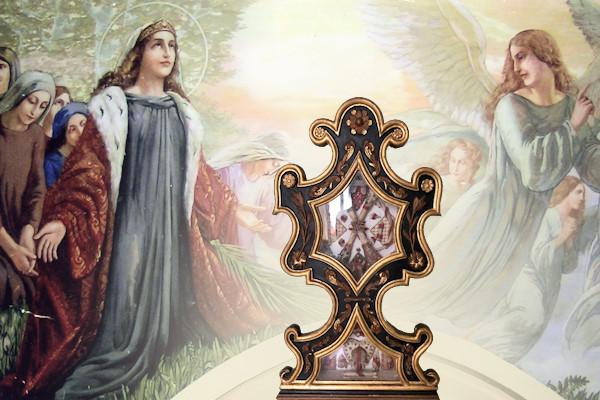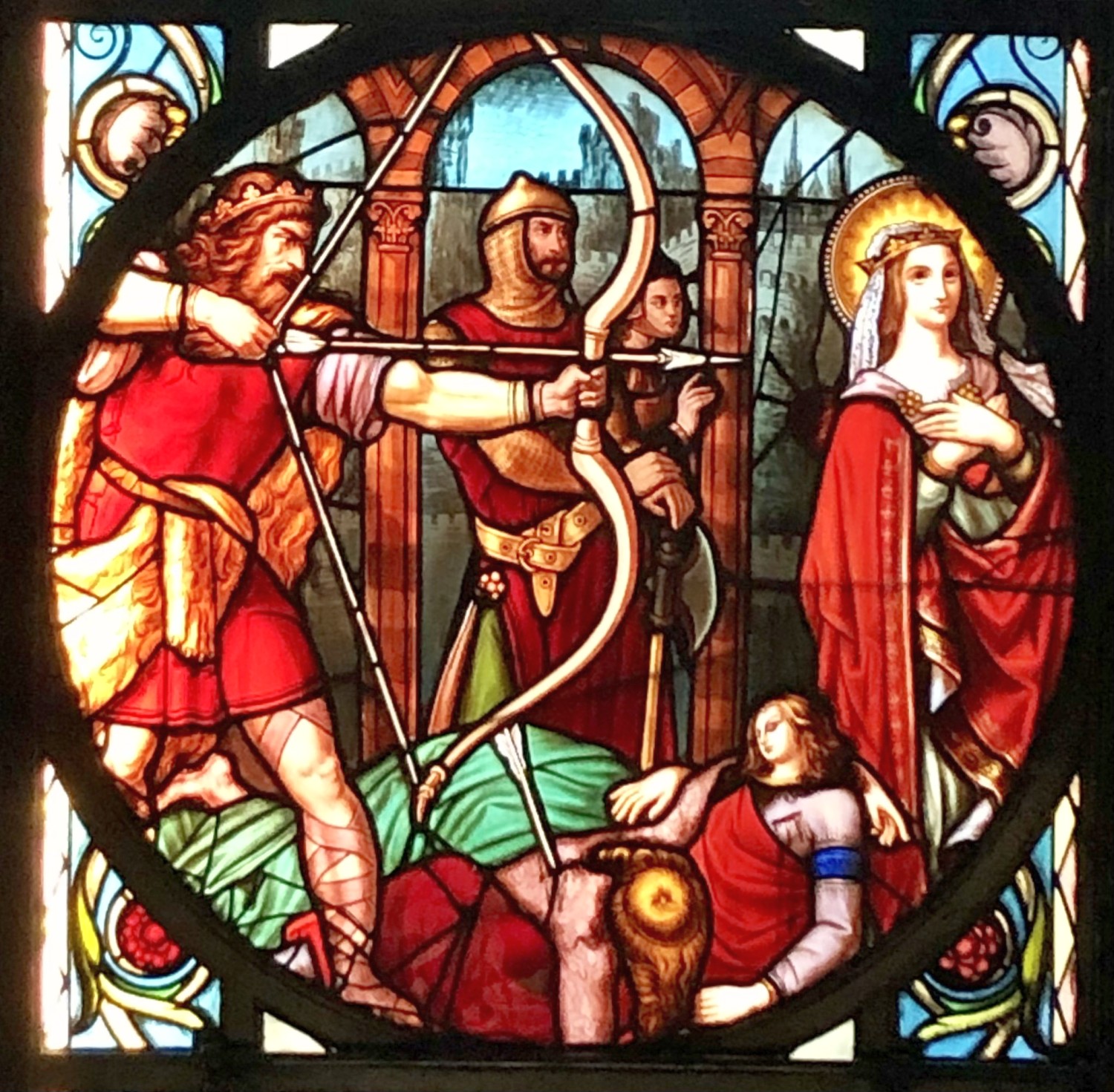Looking back. Short stories from the Archives
17/10/2023

Celebrating St Ursula – 21 October
At the closure of the Cork Community in 2022, the Ireland-Wales Province of the Roman Union made a gift to the Generalate of a precious reliquary (fig. 1) containing some relics of St Ursula and her companions. The large reliquary comes from Cologne and is accompanied by a sheet, with a picture of the Ursuline convent and school on Machaberstrasse (fig. 2), which reads: ‘Herewith I state (verify) that the enclosed reliquary contains relics of St Ursula and her companions brought to this Ursuline Convent in street Machaberstrasse in the 17th and 18th century, from Ursuline Church in thanksgiving'. This reliquary was brought to the Ursuline Convent in Blackrock, Cork, by V.R. Joseph Scannell (later Dean of Cork) from the Ursuline Convent in Cork in 1920. Dean Scannell served as Chaplain to the British Army in World War I when he was a young priest.
 |
 |
|
| 1. Saint Ursula reliquary, Rome, Generalate of the Ursulines of the Roman Union, front (AGUUR©) | 2. Saint Ursula reliquary, Rome, Generalate of the Ursulines of the Roman Union, back (AGUUR©) |
But who is Saint Ursula? Saint Ursula is a legendary Romano-British Christian saint who died on 21 October 383. Her feast day in the pre-1970 General Roman Calendar is 21 October. There is little information about her and the anonymous group of virgin saints who accompanied her and who, on an uncertain date, were killed with her in Cologne.
The story tells of a beautiful princess, Ursula, daughter of the Christian king of Britannia. Honest and wise, she lived consecrating her life choices to the Lord when she was desired by the powerful, and overbearing, King of England as a bride for his son. The messengers sent by the king were refused by Ursula's father, who, however, did not refuse her request for marriage after having been inspired to do so in a vision she had in a dream, on the condition that she had ten virgins to keep her company and comfort her on a devout pilgrimage, along with a thousand other virgins for herself and each of the others, and that the future groom convert to the Christian faith. Having accepted the conditions, preparations were made, and from all parts of the earth the virgins came to gather. Under the leadership of Ursula, the huge procession set off across the sea at the English Channel with a fleet of eleven ships. The fleet landed in Gaul and sailed up the course of the Rhine to Switzerland; Ursula and her retinue continued the pilgrimage all the way to Rome, gathering crowds of believers, including Pope Cyriac (unknown in papal documents, although there was a Pope Siricius from the end of 384 A.D.), and Sulpicius, Bishop of Ravenna. So on their way back, arriving in Cologne at that time besieged by the Huns, the virgins were murdered by the barbarians. Ursola was first spared by Attila who, struck by her beauty, wanted her in marriage; then, when she refused the tyrant, she was pierced by him with an arrow.
|
3. M.A. Barberis, Saint Ursula in the glory of Paradise, Chapel of Christ the King, Rome, Generalate of the Ursulines of the Roman Union, 1936-37 (AGUUR©) |
This is the legendary story told by the sources. Its origin lies in the only authentic document, a fifth-century Latin epigraph found in the Church of St Ursula, located on the Ursulaplatz in Cologne, the city where the saint and her companions are said to have suffered martyrdom at the hands of the invading Huns on their return from Rome. The plaque, however, only speaks of 'virgin martyrs', without mentioning any names or numbers. But the martyrdom of Ursula and the virgins has a historical basis in 8th-century Cologne, thanks to the discovery of a burial ground near the city, from which thousands of skeletons were exhumed: those of Ursula and her companions, it was believed, and the legend was further enriched, even thousands of names. Among the names given is that of the eleven-year-old Ursula, in Latin undecimilia, given transcribed with the Roman numeral XI accompanied by a small sign so as to determine with the transformed number the birth of the legend of the eleven thousand virgins. [1]
The legend was finally settled in the Legenda aurea, a collection of hagiographic biographies written by Jacopo da Varagine, a Dominican friar and bishop of Genoa, from around 1260 until the author's death in 1298. This book was widely circulated and was among the most significant in circulation during Angela Merici's youth. Her father regularly read the pages of this book to his family; it was probably here that Angela first heard of Ursula and Catherine of Alexandria, two important figures who shaped her spirituality and vision, an inspiration reinforced by many works of art of her time.
Why did Angela choose Saint Ursula? Angela was a woman who travelled, listened, prayed, observed and was open to the influences of her time. The legend of the virgins of Cologne was widespread; numerous paintings attest to the popularity of the cult. It is possible that Angela, passing through Venice at the end of 1524, was able to see the cycle of paintings by Vittore Carpaccio for the Scuola di Sant'Orsola (1490-95, now in the Gallerie dell'Accademia at Venice), precisely according to the Legenda Aurea by Jacopo da Varagine.
Angela may also have seen two Brescian paintings: Antonio Vivarini's Polyptych of St. Ursula in the church of San Pietro in Oliveto (1440-45, now preserved in fragments in the Brescia Diocesan Museum), and Moretto's altarpiece of St. Ursula and companions in the church of Santa Maria Maddalena (1537, now in the Pinacoteca of the Castello Sforzesco in Milan), opposite Agostino Gallo's house. In these canvases, according to traditional iconography, Ursula stands in the midst of her companions on which the two banners wave. These paintings represent the expression of the cult of Ursula that rapidly spread throughout Italy, especially in Veneto and Lombardy, thanks to the German Romans passing through. Angela had a special devotion to Catherine of Alexandria; in fact, she founded her Company in 1535 on her feast day (25 November), and it is from the legend of her mystical wedding with Christ that Angela draws her spousal language (Christ the bridegroom, the royal dignity of the Company's virgin), and yet she placed her daughters under the protection of Ursula! At the origin of this choice is perhaps an affinity of temperament, but there is also a similarity of vocation and message related to faith, virginity, courage.
By Emanuela Lauro Ph.D., General Archivist
____________________________________
1. Cf. Wilhelm Levinson, Das Werden der Ursula-Legende, Köln 1928.



